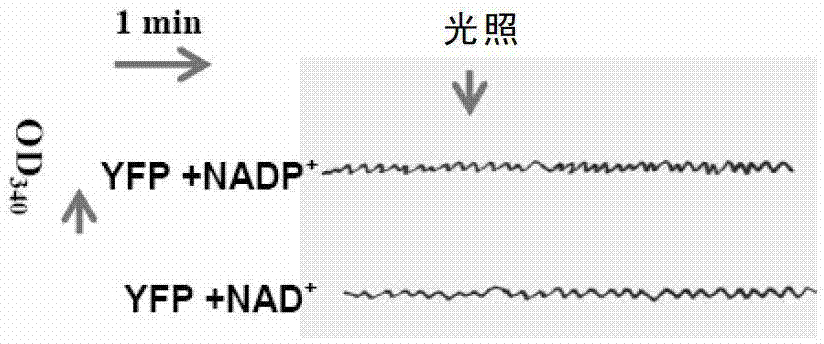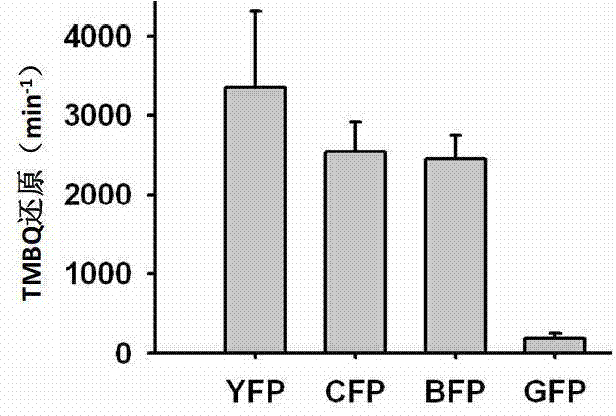Method for improving plant traits
A plant trait, plant technology, applied in the field of biology
- Summary
- Abstract
- Description
- Claims
- Application Information
AI Technical Summary
Problems solved by technology
Method used
Image
Examples
Embodiment 1
[0362] Example 1. LEAT protein uses light energy to catalyze the splitting of water
[0363] 1. LEAT protein catalyzes the reduction of 2,3,5-trimethyl-1,4-p-benzoquinone, an analogue of plastoquinone, by water under the action of light.
[0364] It has been reported that proteins such as GFP can act as electron donors to reduce small molecular compounds such as NAD in oxidation states. + , potassium ferricyanide, and some proteins such as cytochrome C, and proteins with FAD as a prosthetic group (BogdanovAM et al., 2009, Nature Chemical Biology.5:459-461). The present inventors expressed recombinant proteins using purified Escherichia coli. Although pre-illuminated YFP and mCherry can be used as electron donors, one LEAT protein molecule can only provide one electron, and cannot provide electrons continuously under light ( figure 1 ). The photoreduction of quinone molecules catalyzed by LEAT proteins was analyzed by monitoring the decrease in the absorption of quinone mole...
Embodiment 2
[0372] Example 2. Comparison of the ability of LEAT proteins from different sources to catalyze water splitting to release oxygen under light
[0373] Nine fluorescent proteins and three non-fluorescent chromogenic proteins ( Figure 10 ). These 12 proteins belong to different branches such as A, B, C, and D on the evolutionary tree ( Figure 10 ). These 12 fluorescent proteins and non-fluorescent chromogenic proteins plus GFP series and dsRED series fluorescent proteins cover most of the currently reported fluorescent proteins and non-fluorescent chromogenic proteins (Alieva et al., 2008, Diversity and evolution of coarl fluorescent proteins.PLoS One3(7):e2680.doi:10.1371 / journal.pone.0002680), their molecular evolution pathways and amino acid homology are very different from the LEAT proteins of the GFP series and dsRED series ( Figure 11 A and 11B). Using Escherichia coli to express these proteins, it was found that although their fluorescence intensity, absorption spe...
Embodiment 3
[0382]Example 3, Functional research of LEAT protein mCherry transgenic plants
[0383] 1. The expression of mCherry protein in transgenic rape increased the net photosynthetic rate, promoted plant growth, and increased the biomass of transgenic plants.
[0384] After the mCherry transgenic rape is obtained, the mCherry transgenic rape is identified. The results of Southern blot identification of mCherry transgenic rapeseed are as follows Figure 13 B; Fluorescent observation in root cells of transgenic plants Figure 13 C; The results of RT-PCR and Western blot identification of transgenic plants (L1-L6) are as follows Figure 13 d. The expression and subcellular localization of mCherry protein were detected by immunoelectron microscopy. Figure 13 e. It can be seen that the plants L1-L6 are all mCherry positive transformed plants, and the mCherry protein is mainly expressed in the cytoplasm (Cy) and nucleus (N). The present invention uses the T2 generation mCherry tran...
PUM
 Login to View More
Login to View More Abstract
Description
Claims
Application Information
 Login to View More
Login to View More - R&D
- Intellectual Property
- Life Sciences
- Materials
- Tech Scout
- Unparalleled Data Quality
- Higher Quality Content
- 60% Fewer Hallucinations
Browse by: Latest US Patents, China's latest patents, Technical Efficacy Thesaurus, Application Domain, Technology Topic, Popular Technical Reports.
© 2025 PatSnap. All rights reserved.Legal|Privacy policy|Modern Slavery Act Transparency Statement|Sitemap|About US| Contact US: help@patsnap.com



